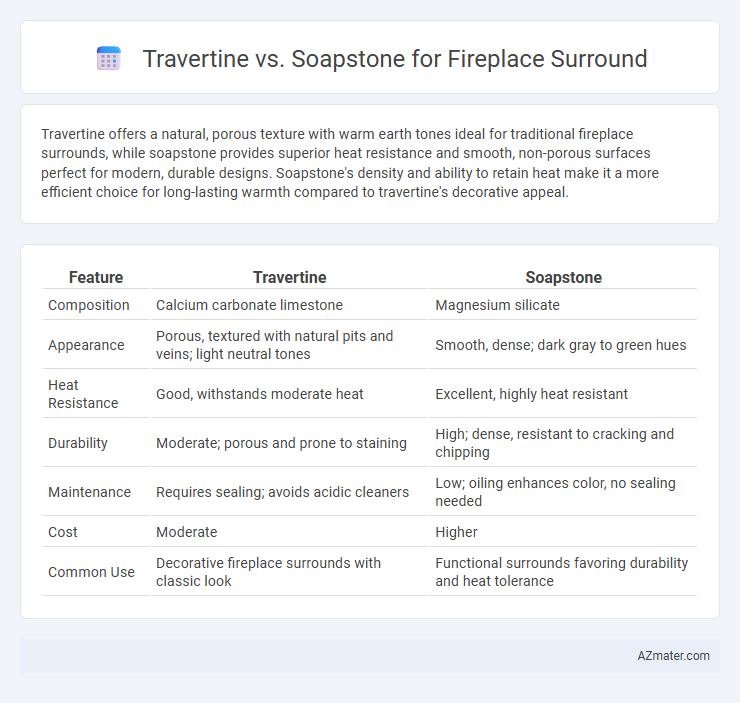Travertine offers a natural, porous texture with warm earth tones ideal for traditional fireplace surrounds, while soapstone provides superior heat resistance and smooth, non-porous surfaces perfect for modern, durable designs. Soapstone's density and ability to retain heat make it a more efficient choice for long-lasting warmth compared to travertine's decorative appeal.
Table of Comparison
| Feature | Travertine | Soapstone |
|---|---|---|
| Composition | Calcium carbonate limestone | Magnesium silicate |
| Appearance | Porous, textured with natural pits and veins; light neutral tones | Smooth, dense; dark gray to green hues |
| Heat Resistance | Good, withstands moderate heat | Excellent, highly heat resistant |
| Durability | Moderate; porous and prone to staining | High; dense, resistant to cracking and chipping |
| Maintenance | Requires sealing; avoids acidic cleaners | Low; oiling enhances color, no sealing needed |
| Cost | Moderate | Higher |
| Common Use | Decorative fireplace surrounds with classic look | Functional surrounds favoring durability and heat tolerance |
Introduction to Travertine and Soapstone
Travertine, a natural limestone formed by mineral springs, offers a porous texture and warm, earthy tones ideal for fireplace surrounds. Soapstone, composed primarily of talc and magnesium silicate, provides exceptional heat retention and a smooth, matte surface resistant to staining and cracking. Both materials combine durability with unique aesthetic qualities, making them popular choices for stylish and functional fireplace designs.
Key Differences Between Travertine and Soapstone
Travertine and soapstone differ significantly in composition, durability, and aesthetic appeal for fireplace surrounds. Travertine, a natural limestone, features porous texture and warm beige tones, offering a classic, elegant look but requires sealing to resist stains. Soapstone, composed mainly of talc, provides exceptional heat resistance and a smooth, matte finish in gray shades, making it highly durable and low-maintenance for long-term use near fireplaces.
Aesthetic Appeal: Travertine vs Soapstone
Travertine offers a warm, natural look with its porous texture and rich veins, often showcasing creamy beige and earth tones that enhance rustic or traditional fireplace surrounds. Soapstone provides a smooth, matte surface with a deep charcoal to dark gray color palette, creating a sleek, modern aesthetic that ages gracefully by developing a unique patina over time. Both stones deliver distinct visual appeals, making travertine ideal for classic elegance and soapstone perfect for contemporary or minimalist designs.
Durability and Longevity Comparison
Travertine offers moderate durability with a porous surface that may require sealing to prevent staining and wear over time, making it suitable for low to moderate heat exposure in fireplace surrounds. Soapstone stands out with exceptional heat resistance, density, and non-porous nature, providing superior longevity and minimal maintenance even under intense fireplace conditions. Choosing soapstone ensures a more durable and long-lasting fireplace surround, especially where frequent heat cycles and durability are primary concerns.
Heat Resistance and Fireplace Performance
Travertine offers moderate heat resistance with a heat tolerance up to approximately 1200degF, making it suitable for fireplace surrounds but prone to etching or discoloration over time under intense heat. Soapstone, known for its exceptional heat retention and resistance, withstands temperatures exceeding 2000degF, allowing it to absorb, store, and radiate heat evenly, enhancing fireplace performance while remaining durable and resistant to cracking. Choosing soapstone over travertine for fireplace surrounds ensures superior heat management and longevity, contributing to more efficient and effective fireplace operation.
Maintenance Needs for Travertine and Soapstone
Travertine requires regular sealing and gentle cleaning with pH-neutral products to prevent staining and etching, as it is porous and susceptible to damage from acidic substances. Soapstone, being non-porous and dense, demands minimal maintenance, typically only needing occasional wiping to remove soot or dust without the risk of staining. The natural durability of soapstone makes it a more low-maintenance choice for fireplace surrounds compared to travertine's higher upkeep requirements.
Cost Analysis: Travertine vs Soapstone
Travertine fireplace surrounds typically cost between $15 to $30 per square foot, offering an affordable natural stone option with moderate durability. Soapstone, priced around $30 to $50 per square foot, commands a higher initial investment due to its superior heat resistance and low maintenance properties. Considering long-term value, soapstone's durability and resistance to staining may reduce replacement and upkeep expenses compared to travertine.
Installation Process Overview
Travertine fireplace surrounds require precise cutting and sealing due to their porous nature, demanding professional installation to prevent staining and damage. Soapstone offers easier installation because of its consistent density and natural resistance to heat and stains, often allowing for straightforward cutting and fitting. Both materials benefit from proper substrate preparation and adhesive use to ensure long-term durability and aesthetic appeal in fireplace surrounds.
Environmental Impact and Sustainability
Travertine and soapstone differ significantly in environmental impact and sustainability for fireplace surrounds. Travertine is a natural limestone formed by mineral springs, requiring extensive quarrying that can lead to habitat disruption and higher carbon emissions due to transportation and processing. Soapstone, composed primarily of talc and dolomite, is more durable and requires less frequent replacement, reducing its long-term environmental footprint and making it a more sustainable choice for eco-conscious homeowners.
Choosing the Best Stone for Your Fireplace Surround
Travertine offers a classic, porous surface that absorbs heat gradually, making it ideal for traditional fireplace surrounds where a warm, inviting ambiance is desired. Soapstone provides superior heat retention and durability, with minimal maintenance due to its non-porous nature and resistance to staining and cracking. Selecting between travertine and soapstone depends on whether aesthetic warmth or long-term resilience and heat efficiency are prioritized for your fireplace surround.

Infographic: Travertine vs Soapstone for Fireplace Surround
 azmater.com
azmater.com